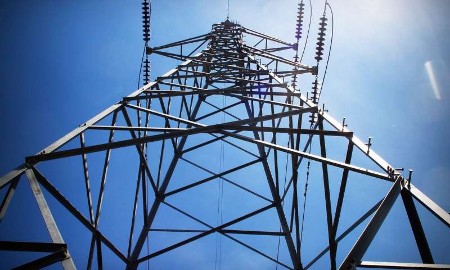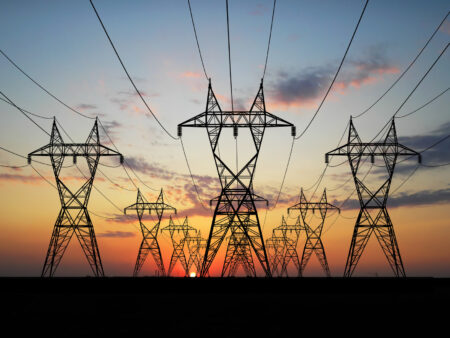June 16, 2020 – The countries and continents of the world are marked by all kinds of highways, some for roads, rail, and pipelines, and others for power transmission. This massive transport infrastructure comes at an enormous environmental cost. Whether it is road, rail, or pipeline, it means landscapes get altered impacting forests, water sources and wildlife. Although it may seem that electrical power transmission corridors are less invasive than other transport infrastructure, they too impact the natural environment. Remember PG&E and the wildfires that raged in California. That’s the dark side of putting up wires carrying kilovolts of current over long distances through wilderness.
Before my wife and I moved to midtown Toronto, we lived in the exurbs of the city where we were quite close to a power right-of-way. That’s where I often walked my dogs. On hot summer days, the wires between the towers would sing and crackle. On hot days they would sag. I wondered why.
Transmitting electricity over wires is all about putting enough power into the line at the outset to ensure that there is enough still there when at the destination. Our homes and businesses rely on a continuous source of steady voltage to run devices like the refrigerator, stove, and the computer on which I’m writing this post.
The process of generating and transmitting power is designed today with built-in losses. First, there are losses that occur at the point of generation within a power plant itself. Then there are the power losses during transmission. The singing and crackling I heard during my walks was an indicator of the lines losing power. The sagging was as well. Apparently, when powerlines get hot they expand their mass which makes them sag.
The high-voltage transmissions that come from power plants will travel hundreds if not thousands of kilometers to get to consumers. A typical 100 to 800 Kilovolt line loses about 2% of the total power it carries during transmission over distances between 100 and 500 kilometers. The further the distance the more power is lost. To compensate for this over longer distances, utility companies will use stepped up transformers intermittently to boost and keep voltage levels stable. When the power gets close to customers it is stepped down through transformers in substations and sent along those telephone pole lines to consumers. So we go from as much as 800 Kilovolts down to 120 in the process.
U.S. estimates show an average loss of 5% of energy generated during transmission. Losses vary depending on whether demand is at peak or low. High demand occurs in North America on hot summer days, and low demand on cool summer nights.
The inefficiencies of power distribution through the current utility network and grid is built into the price of electricity paid by the consumer. But what if we could eliminate the power losses? Experiments using superconducting multi-layered cables show that transmission losses can be cut to near zero. These cables feature layers containing coolant wrapping around the power transmission core. They are made of advanced superconducting materials that are far more expensive than the existing powerlines used today. An infrastructure upgrade to the entire grid would be a multi-decade project costing trillions of dollars to bring North America up to a near-zero power-loss standard. If done, utilities could yield savings by reducing the number of powerplants necessary across the entire grid, and would no longer need stepped up transformers. That would simplify the existing infrastructure and without the entropy and heat produced through power losses in operating the grid, would help in the fight against global warming. To date, however, there is little consensus to move forward with total replacement of the existing powerline infrastructure.
So what if we go another way entirely? What if we eliminate most of the grid and replace it with a distributed energy model that is well-suited to renewable energy projects, modular nuclear power, and other forms of local power generation and storage?
Back in 2016, I published a piece on this blog site that posed the question, “What’s Holding Us Back from a Distributed Energy Model Replacing Existing Power Grids?” What would power distribution and delivery look like in 2100 if we were to go to this type of decentralized way of producing and consuming energy? We would see tens of thousands of power-generating sources from rooftop solar to utility solar. We would see biomass power generation using anaerobic digesters fueled by sewage and garbage. We would see small modular nuclear power plants that could operate safely in a neighbourhood and be refueled in a day. We would see passive geothermal installations in houses and businesses, and utility-sized geothermal powerplants that would replace any remaining coal-fired facilities. We would exploit power from the wind, and from tides and waves. Building clusters would generate their own power distributing it through microgrids to multiple nearby sites and neighbourhoods. And we would see many homes and businesses go grid-free.
For the Developing World that lacks big centralized grids and massive thermal powerplants, they could skip this more than a century-old technology and infrastructure model, and go direct to a decentralized, locally distributed system. It would be equivalent to how current Developing World countries have been able to skip landline telecommunications infrastructure and go to mobile cellphone networks.
Back in 2013, in an article written for The New York Times, just after Hurricane Sandy, John Farrell, of the Institute for Local Self-Reliance, is quoted calling this “a real paradigm shift….not only a shift in the physical generation of power but also the power over the system in terms of who is in control of it and who can benefit from it.” Many in the industry see a decentralized system as better suited to the new mix of power generation technologies that are becoming mainstream and see it as a far more effective way to reduce carbon emissions to mitigate climate change.
There is one additional benefit. In the event of an event like Hurricane Sandy which put much of New Jersey, Long Island, and Manhattan into darkness, a decentralized power generation and distribution system would prove more robust, allowing lights to stay on in many places even when centralized sources of power fail. The Sandy experience demonstrated the efficacy of decentralized, distributed power when New York University’s Greenwich Village campus and a housing complex in the Bronx, both kept their lights on using microgrids that they could temporarily disconnect from the main grid.
That’s not the case for the majority of the power grid upon which we rely today. Having lived through a number of large blackouts in my lifetime, including the 1965 Northeastern U.S. and Great North America Blackout of 2003, I still remember the vulnerability felt when the grid failed. My wife and I went out and bought sterno kits and lamps after 2003 and we keep them around in anticipation that we will see a reoccurrence in years to come as the grid continues to age.










